
Chocolate is a food made from roasted and ground cacao seed kernels that is available as a liquid, solid, or paste, either on its own or as a flavoring agent in other foods. Cacao has been consumed in some form since at least the Olmec civilization, and the majority of Mesoamerican people ─ including the Maya and Aztecs ─ made chocolate beverages.
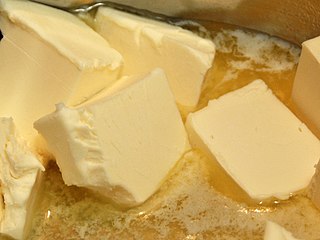
Butter is a dairy product made from the fat and protein components of churned cream. It is a semi-solid emulsion at room temperature, consisting of approximately 80% butterfat. It is used at room temperature as a spread, melted as a condiment, and used as a fat in baking, sauce-making, pan frying, and other cooking procedures.

The peanut, also known as the groundnut, goober (US), pindar (US) or monkey nut (UK), is a legume crop grown mainly for its edible seeds. It is widely grown in the tropics and subtropics, important to both small and large commercial producers. It is classified as both a grain legume and, due to its high oil content, an oil crop. World annual production of shelled peanuts was 44 million tonnes in 2016, led by China with 38% of the world total. Atypically among legume crop plants, peanut pods develop underground (geocarpy) rather than above ground. With this characteristic in mind, the botanist Carl Linnaeus gave peanuts the specific epithet hypogaea, which means "under the earth".

Cake is a flour confection made from flour, sugar, and other ingredients, and is usually baked. In their oldest forms, cakes were modifications of bread, but cakes now cover a wide range of preparations that can be simple or elaborate, and which share features with desserts such as pastries, meringues, custards, and pies.

Ghee is a type of clarified butter, originating from India. It is commonly used in India for cooking, as a traditional medicine, and for religious rituals.

Peanut butter is a food paste or spread made from ground, dry-roasted peanuts. It commonly contains additional ingredients that modify the taste or texture, such as salt, sweeteners, or emulsifiers. Consumed in many countries, it is the most commonly used of the nut butters, a group that also includes cashew butter and almond butter.

A crouton is a piece of rebaked bread, often cubed and seasoned. Croutons are used to add texture and flavor to salads—notably the Caesar salad— or eaten as a snack food.

Mashed potato or mashed potatoes, colloquially known as mash, is a dish made by mashing boiled or steamed potatoes, usually with added milk, butter, salt and pepper. It is generally served as a side dish to meat or vegetables. Roughly mashed potatoes are sometimes called smashed potatoes. Dehydrated instant mashed potatoes and frozen mashed potatoes are available. Mashed potatoes are an ingredient in other dishes, such as dumplings and gnocchi.
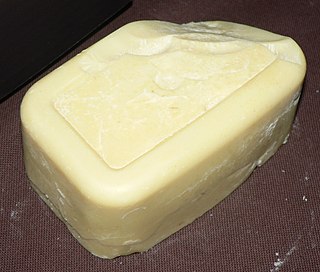
Cocoa butter, also called theobroma oil, is a pale-yellow, edible fat extracted from the cocoa bean. It is used to make chocolate, as well as some ointments, toiletries, and pharmaceuticals. Cocoa butter has a cocoa flavor and aroma. Its melting point is slightly below human body temperature.

Corn on the cob is a culinary term for a cooked ear of sweet corn (maize) eaten directly off the cob. The ear is picked while the endosperm is in the "milk stage" so that the kernels are still tender. Ears of corn are steamed, boiled, or grilled usually without their green husks, or roasted with them. The husk leaves are removed before serving.
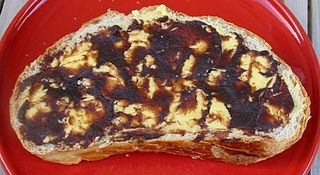
Apple butter is a highly concentrated form of apple sauce produced by long, slow cooking of apples with cider or water to a point where the sugar in the apples caramelizes, turning the apple butter a deep brown. The concentration of sugar gives apple butter a much longer shelf life as a preserve than apple sauce.
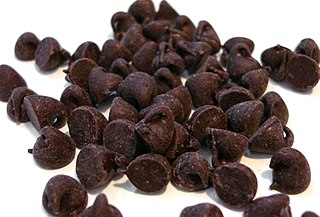
Chocolate chips or chocolate morsels are small chunks of sweetened chocolate, used as an ingredient in a number of desserts, in trail mix and less commonly in some breakfast foods such as pancakes. They are often manufactured as teardrop-shaped volumes with flat circular bases; another variety of chocolate chips have the shape of rectangular or square blocks. They are available in various sizes, usually less than 10 millimetres (0.39 in) in diameter.

Biscocho, also spelled biskotso, refers to various types of Filipino twice-baked breads, usually coated with butter and sugar, or garlic in some cases. Biscocho is most strongly associated with the versions from the province of Iloilo, although it actually exists nationwide in various forms. It is also known as biscocho duro, machacao, or matsakaw. It is also historically known as pan de caña.
Chocolate is a food product made from roasted and ground cocoa pods mixed with fat and powdered sugar to produce a solid confectionery. There are several types of chocolate, classified primarily according to the proportion of cocoa and fat content used in a particular formulation.

Toast is sliced bread that has been browned by radiant heat. The browning is the result of a Maillard reaction altering the flavor of the bread and making it firmer. The firm surface is easier to spread toppings on and the warmth can help butter reach its melting point. Toasting is a common method of making stale bread more palatable. Bread is toasted using a toaster or a toaster oven. Toast may contain carcinogens (acrylamide) caused by the browning process.
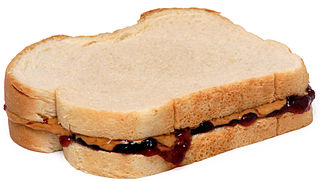
A peanut butter and jelly sandwich (PB&J) consists of peanut butter and fruit preserves—jelly—spread on bread. The sandwich may be open-faced, made of a single slice of bread folded over, or made using two slices of bread. The sandwich is popular in the United States, especially among children; a 2002 survey showed the average American will eat 1,500 peanut butter and jelly sandwiches before graduating from high school. There are many variations of the sandwich, starting with the basic peanut butter sandwich or jam sandwich.

Beurre maître d'hôtel, also referred to as maître d'hôtel butter, is a type of compound butter of French origin, prepared with butter, parsley, lemon juice, salt and pepper. It is a savory butter that is used on meats such as steak, fish, vegetables and other foods. It may be used in place of a sauce, and can significantly enhance a dish's flavor. Some variations with a sweet flavor exist. It is usually served cold as sliced disks on foods, and is sometimes served as a side condiment.

Dairy salt is a culinary salt product used in the preparation of butter and cheese products that serves to add flavor and act as a food preservative. Dairy salt can vary in terms of quality and purity, with purer varieties being the most desirable for use in foods. Dairy salt has been used since at least the 1890s in England and the United States. In butter preparation, it serves to retain moisture, while in cheeses, it tends to reduce water content and slow the ripening process.

Yayık ayranı, also known as Turkish buttermilk, is a traditional Turkish drink produced from fermented buttermaking by-products, water and salt. It has been traditionally prepared in barrel churns or skin bags. Despite the similar name, it is distinct from ayran. Goat, sheep, or cow's milk can be used for Turkish buttermilk production. Certain acid curd cheeses such as çökelek could also be obtained from yayık ayranı when heated.




















